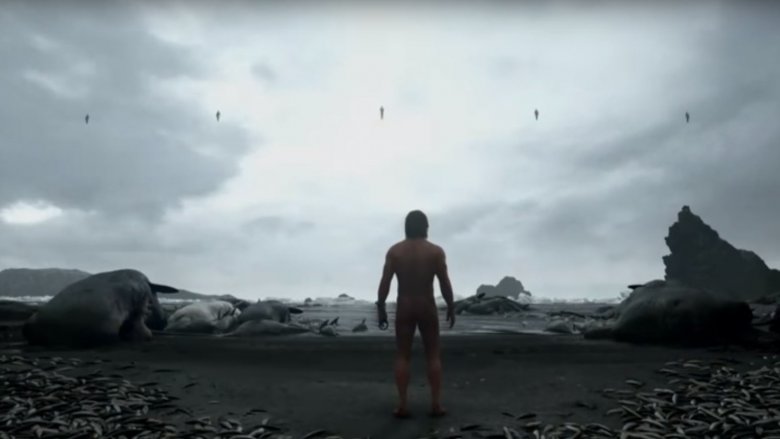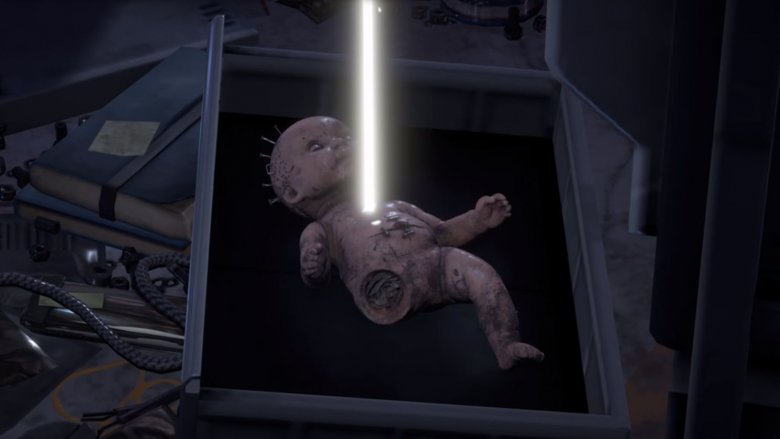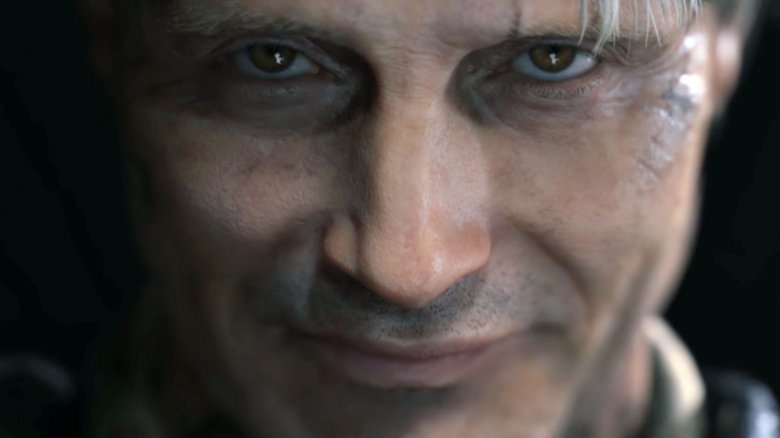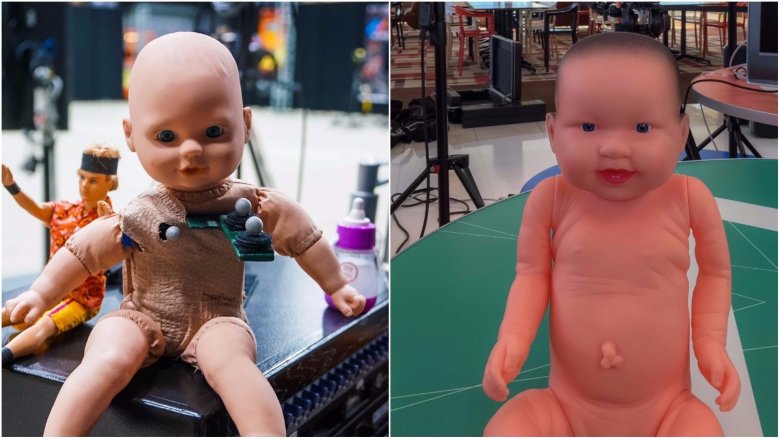Things You Don't Know About Death Stranding
You actually know more about Death Stranding than you think. If you've been paying attention, you know it's the next game from Metal Gear Solid mastermind Hideo Kojima, his first since his dramatic breakup with Konami a couple years back. If you've seen the trailers, you know it stars The Walking Dead's Norman Reedus and Hannibal and Rogue One's Mads Mikkelsen. Director Guillermo del Toro, who collaborated with Kojima on the unreleased Silent Hills, plays a role too. The game takes place in an open-world setting, and will have some kind of multiplayer component, in addition to a lengthy (and weird) single-player campaign.
And yet, when it comes to specifics, Kojima plays things close to the vest. Death Stranding looks like it's going to be an unusual experience, and Kojima is doing everything he can to keep the mystery alive until the game's as-yet unknown release date. Still, occasionally, a few details slip through. Here are some of the stranger ones.
The title refers to whales
Death Stranding is all about connections—in some cases, quite literally. In an interview with Wired, Kojima explained that the story is about "what you call 'strands' in psychology—how people are connected." He emphasizes that he's talking literally and metaphorically: Death Stranding involves connecting players to one another via gameplay, and explores Kojima's ideas about "trying to connect one character to another, or to connect life and death."
The title invokes those kinds of "strands" (and the first trailer is full of literal connecting strands, like umbilical cords) but it's got another meaning, too. When a whale wades into shallow water and beaches itself, Marine biologists call it "Cetacean stranding." More often than not, stranding doesn't end well. In most cases, the beached whales die of dehydration, or drown when the high tide covers their blowholes. Nobody's quite sure why it happens, either. In some cases, experts suspect that whales head to shore to escape predators, while others hypothesize that whales' echolocation-based navigation systems can't handle certain types of topography.
Or, maybe it's something else. Death Stranding may not give any answers, but given that the first trailer opens on a beach full of dead wildlife, including dead whales, the title can't be a coincidence.
It's going to create a whole new genre
Kojima tends to talk about Death Stranding using metaphors, focusing more on philosophy than mechanics, making it difficult to tell what players will actually do once the game comes out. We know it's going to take place in an open-world setting like Grand Theft Auto, Horizon Zero Dawn, or Assassin's Creed. We know, at a very basic level, that it's going to be an "action" title, and that it won't be a horror game like Kojima's previous collaboration with Reedus, Silent Hills.
Beyond that, however, things remain a mystery—but that may not be because Kojima is playing coy. The words that we need to discuss Death Stranding may not exist yet.
While talking to Digital Spy, Kojima reflected on his days making the original Metal Gear. Pointing out that "Metal Gear, it was an action game but it was different because the main thing was about hiding," he recalled how people only started calling it a "stealth" game later, when it became clear that the game industry needed a new word for that type of game. Death Stranding is like that too: "The player will be controlling Norman but by playing it they will find something different, something that won't fit in established terms."
Kojima also likes to use a short story called Rope by Japanese author Kōbō Abe to explain what he means. In the story, early humans use sticks as weapons, thereby inventing tools. The second tool that they create is a rope. While the stick "was made to keep away bad things," the rope's purpose is "to keep good things close to you." Currently, most video games focus on the stick—punches, kicks, guns, and other forms of aggression. With Death Stranding, Kojima wants to make video games evolve by introducing the equivalent of a rope into gaming's vocabulary.
Beyond that, however, Kojima isn't talking. He wants to keep the surprise fresh. As he put it, "It would be like telling you who's the killer in a mystery novel."
The developers of Horizon Zero Dawn let Kojima use their game engine for free
If you haven't played Horizon Zero Dawn, you really should. Not only is it one of the best games of 2017, but according to Uncharted 4 and The Last of Us director Neil Druckmann, Horizon set a new bar for video game graphics.
That's thanks largely to Guerrilla Games' proprietary Decima Engine, which makes the whole thing run, and as such it's no surprise that Kojima wanted to use Decima to bring Death Stranding to life. Instead of signing a contract or demanding a fee, however Guerrilla gave Kojima access to the engine for free, no strings attached. "When we met [Guerrilla] they suddenly gave us a box, a very pretty box. When we opened the box, there was a USB dongle inside that had the source code for the engine," he recalled. "They simply said, 'Mr. Kojima please use this engine,' and we thought these people are incredible."
There is one catch, however: any changes that Kojima Productions makes to Decima (and reportedly, there are quite a few) need to be shared with Guerrilla, allowing both companies to develop the engine together. According to Kojima, it's a deal that's worked out beautifully. "Over the course of 6 months we passed the code back and forth between Guerrilla Games and Kojima Productions, working off the same code base," he said. "At this point our code had completely merged together."
Horizon Zero Dawn is full of Death Stranding Easter eggs
In fact, the collaboration between Guerrilla Games and Kojima Productions proved so successful that the former stuffed a bunch of Death Stranding references into their open-world sci-fi adventure.
In Horizon Zero Dawn, players can find a "Stranded Necklace," a "Stranded Figure," and "Stranded Shackles." As far as anyone can tell, those refer to Norman Reedus' dog tags, which appear in Death Stranding's first trailer, the creepy doll that floats by Guillermo Del Toro in trailer number two, and the handcuffs that Reedus' character seems to wear, respectively. Further, all three of these items appear in Horizon's menus with an icon modeled after Kojima Productions' new mascot, Ludens.
Some of the other Death Stranding references aren't quite as obvious. Mainly, once players collect all three Stranded items, they can hand them over to a quest-giver in exchange for a box that contains a pair of warm socks. The socks don't do anything (they don't even sell for very much money), and it's not clear if they're an Easter egg or a throwaway item. Until Death Stranding comes out, the confusion will most likely continue.
Even Death Stranding's stars don't understand what's going on in the story
Anyone who's played a Metal Gear Solid game knows Kojima revels in serpentine plots that twist just when you think they're going to turn, and that rely on deep, almost impenetrable backstories. Death Stranding looks like more of the same, with some extra surreal metaphors sprinkled on top. In fact, it's so ambitious and complicated that neither Norman Reedus nor Mads Mikkelsen really get it, although they're excited to star in the game anyway.
Kojima pitched Death Stranding to Reedus during San Diego's Comic-Con International, and the actor signed on immediately, despite his confusion. "He had some stuff on an iPad that he wanted to show me," Reedus recalled. "I was like, 'Whatever you want to do, let's do it. I don't even know what you're talking about.'"
Mikkelsen has a similar story. Mads isn't a gamer, and his son needed to explain why Kojima is so important, but Mikkelsen took the meeting. "He was trying to tell me the full plot of the game, and it's so elaborate that, I mean, I got lost but I really wanted to learn more," Mikkelsen said at Saudi Comic-con. He told a similar story to Birth.Movies.Death. "He's a very brilliant man. I mean ... the stuff he told me? I only understood some of it," he admitted. "I was like, this is crazy, what he's doing. I loved it."
There might be a tie to Akira
Clearly, Hideo Kojima has Akira on the brain. When fans asked when Death Stranding is going to come out (officially, it has no release date), Kojima Productions replied on Twitter: "Before the Tokyo Olympic Games. Before the new Akira."
The Tokyo Olympics happen in 2020. The Akira reference isn't as clear. Warner Bros. has been trying to get a live-action Akira film off the ground for years—recently, Get Out's Jordan Peele reluctantly turned down the chance to step into the director's chair—but the movie isn't officially in production, and has no definite release date.
So why mention Akira at all? It could just be a joke. The live-action adaptation of the manga and anime has been in development for so long that it may never happen, giving Kojima Productions a pretty easy release date to hit. But maybe there's more to it. For one, Akira takes place in 2019 (oddly, right before the 2020 Olympics, which were pure fiction when the manga and film were released), which could be a possible launch date. Some fans think they've found Akira connections in Death Stranding's two trailers, too. Tanks that appear behind Guillermo del Toro's character look kind of like the ones in Akira. Like Akira, Death Stranding looks like it's set in a world ravaged by nuclear war, and has something to do with human experimentation.
Is it a stretch? Oh yes. Is it also fun to think about for fans of both Kojima and the formative anime film? Absolutely.
The music video for Low Roar's 'Give Me an Answer' is inspired by Death Stranding
If you've been following the Death Stranding news, then you know Low Roar—you just may not realize it. The Icelandic rock band's been around in various forms since 2002, when it was called Audrye Sessions, but they reached a new level of fame when two of their songs, "I'll Keep Coming" and "Easy Way Out," were hand-picked by Hideo Kojima to accompany the Death Stranding launch trailers.
Low Roar isn't letting all of this attention go to waste, either. When producing the video for their next single, "Give Me An Answer," director Marko Bell decided to use Death Stranding as the launching point for a trippy, virtual reality-themed sci-fi story. "Knowing about the band's past made me think it would be fun to create a world where certain fans could physically enter the game Death Stranding before it came out," Bell explained. "This opened the door to questions that created the narrative you see in the video."
The "Give Me An Answer" video isn't directly tied to Death Stranding, and watching it won't give you any clues about the game's plot. It's a spiritual spinoff, not a literal one. Still, if you liked the haunting music that helped give the trailers their haunting atmosphere, check it out.
The baby has a name—two of 'em, in fact
For some reason, Death Stranding's promotional materials are chock-full of babies. In the first trailer, Norman Reedus picks up a lost baby on a beach, cradling it to his body before it disappears. In the second, Guillermo del Toro cradles a womb-like capsule with a living baby inside while a mangled doll floats at his feet.
Kojima Productions filmed both trailers using motion capture technology, and didn't have to use real babies in the production of either video. On set, dolls stood in for the infants. Animators added the motion later. Still, that didn't stop Hideo Kojima from giving the babies names. In a series of tweets, Kojima revealed that the prop baby held by Norman Reedus is named "Lu #2," and lives in San Diego. The other baby is named "Lu #1." His place of residence was not revealed.
Oh, and by the way, both dolls are absolutely terrifying. If you think Death Stranding has some disturbing or weird imagery, forget about it. Behind the scenes is where the real terror resides.





